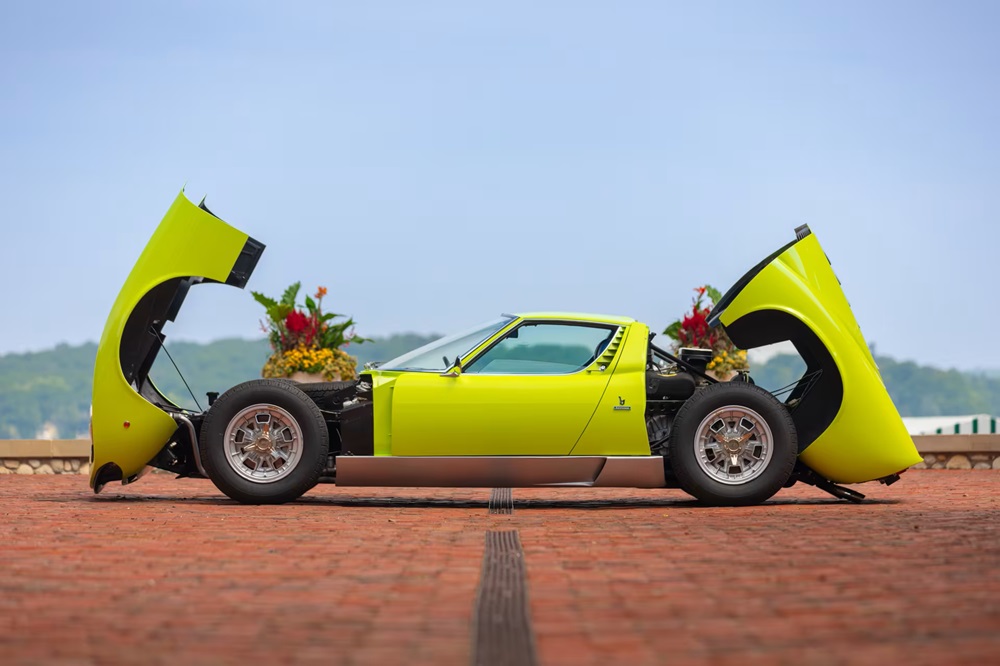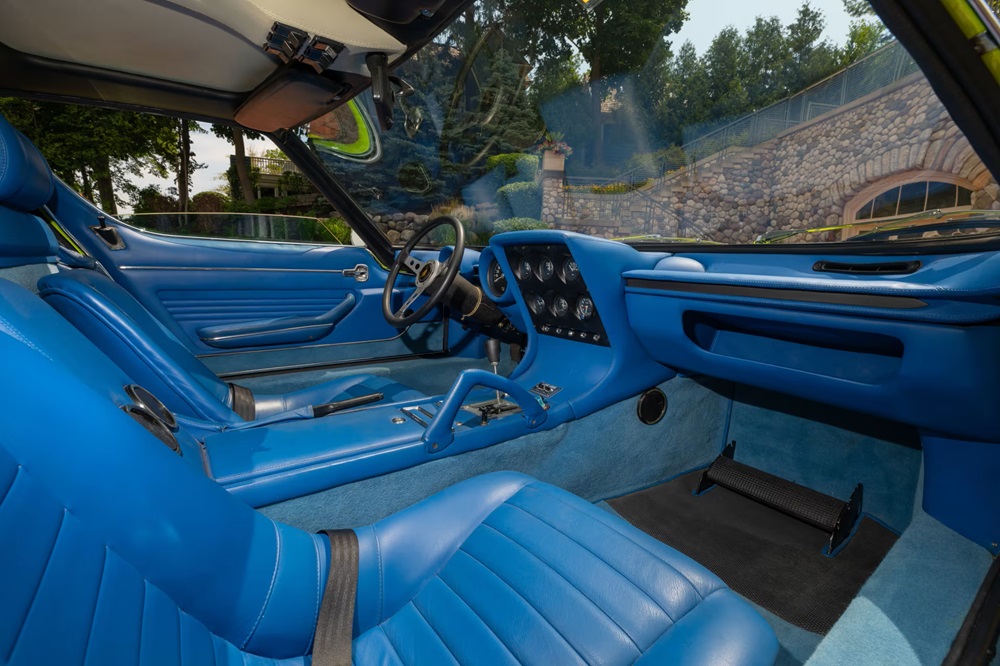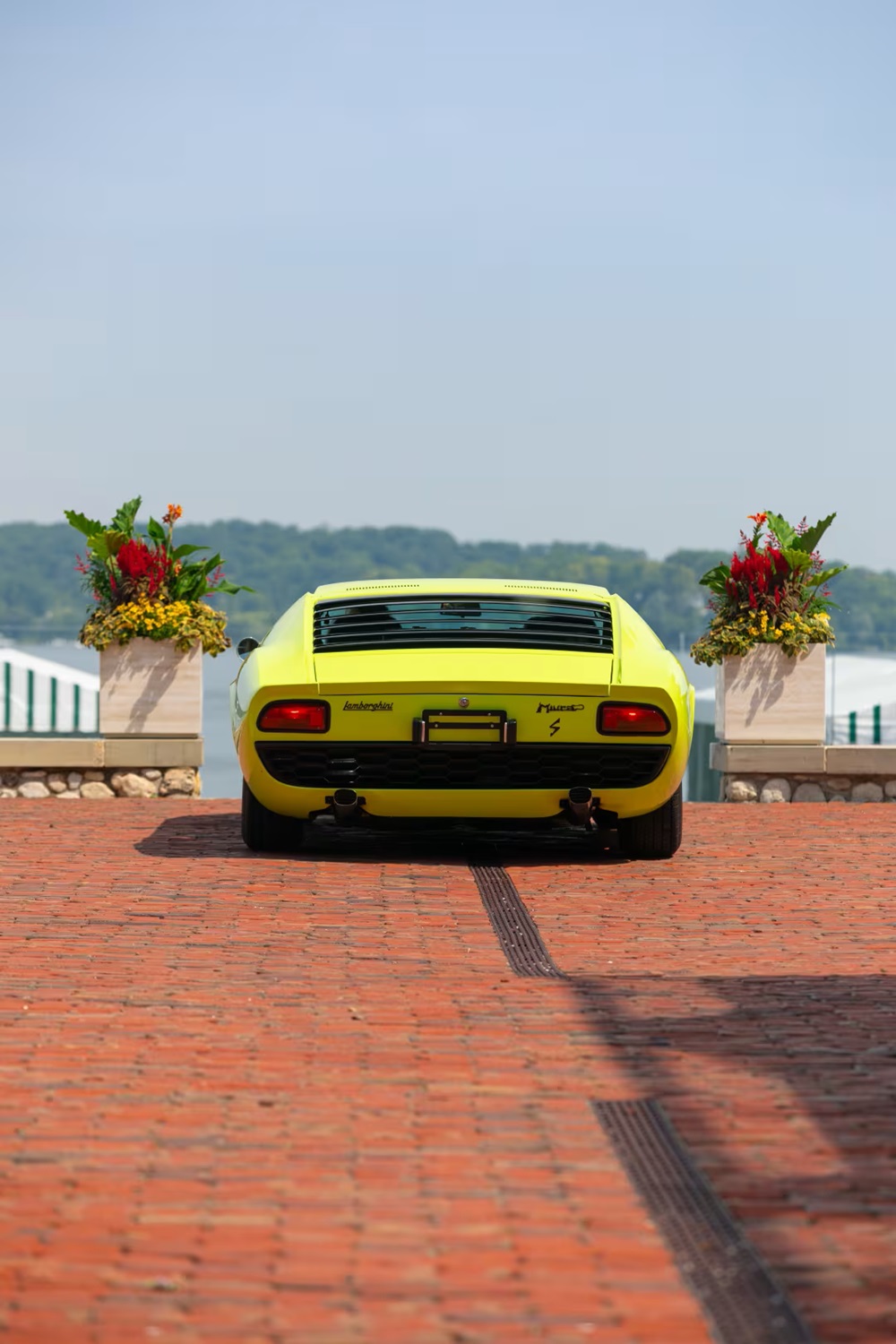Demolishing all previously accepted notions as to how an elite-level, high-performance sports/GT car should look, feel and behave in one fell swoop, the two-seat, midengine, V-12 Miura stands taller than ever as the first truly cohesive expression of the supercar genre as its known today. The fastest production road car upon release, the Miura was revolutionary, its unique midengine layout forever setting the standard for high-performance sports cars. It was a highly desirable car when introduced in 1966, and examples like this 1969 Lamborghini Miura P400 S headed to Mecum Monterey this August prove that desirability has only grown in the years since.

Developed during the early 1960s and produced from 1964 to 1966, the Lamborghini 350 GT debuted as the bold Italian marque’s first production model following the Franco Scaglione-designed 350 GTV prototype that debuted at the 1963 Turin show. While the 350 GT and its increasingly refined derivatives reflected company founder Ferruccio Lamborghini’s vision for grand-touring excellence and delivered several credible “shots across the bow” to archrival Ferrari, the Miura that soon followed them by the latter 1960s represented a devastating nuclear strike.
Boasting race-derived mechanical specifications, staggering all-around performance and aggressively stunning looks, the Miura was developed by a seven-man “dream team” of Italy’s finest engineers of the 1960s including Giam Paolo Dallara and Paolo Stanzani. Immortal as the world’s first production supercar, Lamborghini’s Miura was first shown unnamed and simply in bare rolling chassis form at the 1965 Turin Motor Show. Fully clothed in stunning alloy coachwork penned by Marcello Gandini for Bertone, it sent shockwaves worldwide at its formal March 1966 Geneva Salon debut and drew orders on the spot from the wealthiest and most influential personalities and enthusiasts of the era.

Named in honor of the notoriously fierce fighting bulls bred by Don Eduardo Miura, the Miura remains impressive today. Engineering highlights included a lightweight chassis, all-independent underpinnings, tilting front and rear body sections, and 4-wheel disc brakes. The Miura’s exotic DOHC V-12 engine even featured early development by none other than legendary engineer Giotto Bizzarrini, who was largely responsible for Ferrari’s brilliant 250 GTO prior to the infamous “Palace Revolt” that liberated the talents of many of the best Italian engineers, racing mechanics and team managers from Maranello.
Initially designated P400 in recognition of its midmounted 4.0L V-12 engine developing 350 HP, the Miura immediately made the best of Ferrari’s contemporary road models seem dated in comparison. First available in 1967, the Miura LP400 backed up its provocative looks with shattering performance including reported top speeds nearing 170 MPH.
While designed essentially as a front-line sports racing car worthy of entry into the 24 Hours of Le Mans and looking the part, the Miura was in fact conceived as a blindingly fast and glamorous road car without racing pretensions, given the rapidly escalating costs of operating international-level racing teams during the 1960s. When new, the Miura was the unqualified car of choice for the era’s top entertainers, rock stars and wealthy playboys. Today, it continues to rank highly as one of the most beautiful and potent automobiles ever conceived with few, if any, worthy peers.
Miura production progressed through three distinct and progressively faster variations: the P400, P400 S and P400 SV. Early cars became available to buyers in 1967 and production continued through 1973. Development was swift and relentless, spearheaded by Dallara and New Zealander Bob Wallace, Lamborghini’s development driver and engineer. The first fruit of this work was the enhanced Miura LP400 S, with the S suffix denoting its “Spinto,” or tuned, specification. First shown at the 1968 Turin show, the LP400 S offered improved handling, build quality and interior comfort.

The mighty 3922cc Lamborghini V-12 engine was fortified on the LP400 S with reworked cylinder heads and revised Weber carburetion, yielding a useful 20 HP bump to a 370 HP factory-advertised rating. Rear-suspension updates and newly available, state-of-the-art 70-series Pirelli Cinturato radial tires enhanced handling, while new ventilated disc-brake rotors reduced fade under hard usage. Visually identified by its “S” tail-panel script matching the stylized “Miura” model-identification logo, the Miura LP400 S received further selective upgrades during its production run, which spanned from November 1968 until the advent of the P400 SV in March 1971 with just 338 examples of the LP400 S series produced.
Ever since they were new, all examples of the Miura have been enthusiastically and rightly followed and documented as the world’s first midengine, two-seater sports/GT car ever produced. Built at Lamborghini’s historic, original Sant’Agata Bolognese factory in Italy on January 29, 1969, this 1969 Lamborghini Miura P400 S bears Chassis No. 3919, Engine No. 2772 and Production No. 3223.
 Naturally drawing wealthy and experienced owners and drivers, this LP400 S was previously owned by colorful USAC, CART and NASCAR racing driver David “Salt” Walther, who gained his nickname for driving racing boats and unlimited hydroplanes near Miami in his youth. The LP400 S benefits from a three-year, concours-level restoration completed in 2008 by the renowned Bobileff Motorcar Company of San Diego, California. Beautifully complemented by a blue-upholstered interior, the Miura’s unforgettable Verde Miura (Miura Green) exterior was refinished in 2017.
Naturally drawing wealthy and experienced owners and drivers, this LP400 S was previously owned by colorful USAC, CART and NASCAR racing driver David “Salt” Walther, who gained his nickname for driving racing boats and unlimited hydroplanes near Miami in his youth. The LP400 S benefits from a three-year, concours-level restoration completed in 2008 by the renowned Bobileff Motorcar Company of San Diego, California. Beautifully complemented by a blue-upholstered interior, the Miura’s unforgettable Verde Miura (Miura Green) exterior was refinished in 2017.
The transverse-mounted 3.9L DOHC V-12 engine is an artwork in its own right, and all four Weber carburetors were rebuilt in 2020. A 5-speed manual transmission/rear transaxle delivers the power to the road. Handsome Campagnolo three-ear, knock-off wheels, fitted with new Pirelli Cinturato tires in 2024, deliver road contact.
Service and maintenance applied to this stunning Miura include an electrical system overhaul performed in 2018, which comprised replacement of the starter, a 100-amp alternator upgrade, battery and cable replacement, and installation of a new voltage regulator. Drivetrain service includes replacement of the crown gear between the starter and flywheel with a factory equivalent in 2021 and installation of a new clutch wheel cylinder in 2023. The muffler was replaced most recently in 2023. Extensive service records accompany the Miura.
While the Miura is indeed a technical and styling tour de force in every respect with an unforgettably purposeful presence and cohesive design, its many individual features are captivating in and of themselves including the classical gated shift quadrant, chrome window trim, rear-window louvers and, of course, the “eyelashes” and chrome trim surrounding the headlamps. The driver is greeted by a handsome three-spoke steering wheel, large-diameter tachometer and speedometer, and gauges monitoring the car’s vital signs.
Designed and built primarily to deliver high performance, the Miura’s passenger amenities are select and limited to the central console with a passenger grab handle, power window lifts and a locking glovebox. Dual exhaust outlets deliver an unforgettably howling note as you shift the competition-style rear transaxle, letting the outside world know you’re behind the wheel of a rare example of the world’s first midengine, two-seat car and quite likely the first true supercar ever created.
find more news here…










